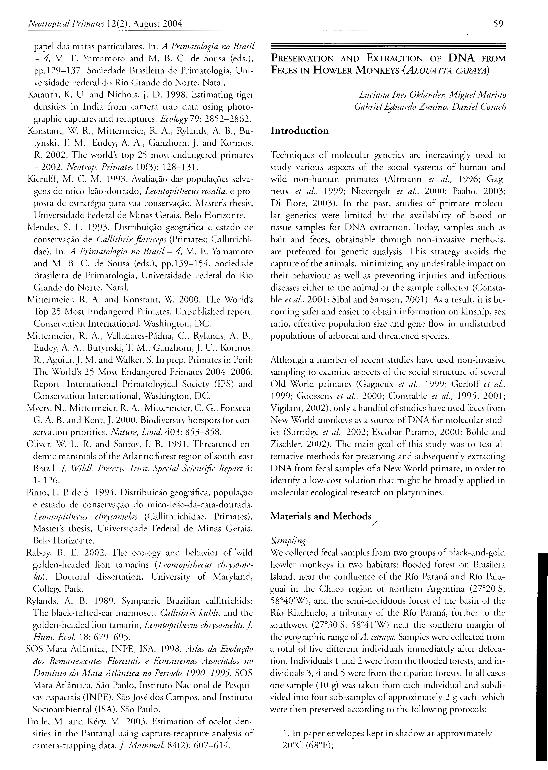Mostrar el registro sencillo del ítem
dc.contributor.author
Oklander, Luciana Inés

dc.contributor.author
Marino, Miguel Eduardo

dc.contributor.author
Zunino, Gabriel Eduardo

dc.contributor.author
Corach, Daniel

dc.date.available
2022-02-21T17:57:42Z
dc.date.issued
2004-08
dc.identifier.citation
Oklander, Luciana Inés; Marino, Miguel Eduardo; Zunino, Gabriel Eduardo; Corach, Daniel; Preservation and Extration of DNA from Feces in Howler Monkeys (Aluatta caraya); BioOne; Neotropical Primates; 12; 8-2004; 59-63
dc.identifier.issn
1413-4705
dc.identifier.uri
http://hdl.handle.net/11336/152403
dc.description.abstract
Techniques of molecular genetics are increasingly used tostudy various aspects of the social systems of human andwild non-human primates (Altmann et al., 1996; Gagneuxet al., 1999; Nievergelt et al., 2000; Paabo, 2003;Di Fiore, 2003). In the past, studies of primate moleculargenetics were limited by the availability of blood ortissue samples for DNA extraction. Today, samples such ashair and feces, obtainable through non-invasive methods,are preferred for genetic analysis. This strategy avoids thecapture of the animals, minimizing any undesirable impact ontheir behaviour as well as preventing injuries and infectiousdiseases either to the animal or the sample collector (Constableet al., 2001; Sibal and Samson, 2001). As a result, it is becomingsafer and easier to obtain information on kinship, sexratio, effective population size and gene flow in undisturbedpopulations of arboreal and threatened species.Although a number of recent studies have used non-invasivesampling to examine aspects of the social structure of severalOld World primates (Gagneux et al., 1999; Gerloff et al.,1999; Goossens et al., 2000; Constable et al., 1995, 2001;Vigilant, 2002), only a handful of studies have used feces fromNew World monkeys as a source of DNA for molecular studies(Surridge et al., 2002; Escobar-Paramo, 2000; Böhle andZischler, 2002). The main goal of this study was to test alternativemethods for preserving and subsequently extractingDNA from fecal samples of a New World primate, in order toidentify a low-cost solution that might be broadly applied inmolecular ecological research on platyrrhines.
dc.format
application/pdf
dc.language.iso
eng
dc.publisher
BioOne
dc.rights
info:eu-repo/semantics/openAccess
dc.rights.uri
https://creativecommons.org/licenses/by-nc-sa/2.5/ar/
dc.subject
DNA extraction
dc.subject
feces
dc.subject
DNA typing
dc.subject
Primates
dc.subject.classification
Bioquímica y Biología Molecular

dc.subject.classification
Ciencias Biológicas

dc.subject.classification
CIENCIAS NATURALES Y EXACTAS

dc.title
Preservation and Extration of DNA from Feces in Howler Monkeys (Aluatta caraya)
dc.type
info:eu-repo/semantics/article
dc.type
info:ar-repo/semantics/artículo
dc.type
info:eu-repo/semantics/publishedVersion
dc.date.updated
2022-01-06T15:03:44Z
dc.journal.volume
12
dc.journal.pagination
59-63
dc.journal.pais
Estados Unidos

dc.description.fil
Fil: Oklander, Luciana Inés. Consejo Nacional de Investigaciones Científicas y Técnicas. Centro Científico Tecnológico Conicet - Nordeste. Instituto de Biología Subtropical. Instituto de Biología Subtropical - Nodo Posadas | Universidad Nacional de Misiones. Instituto de Biología Subtropical. Instituto de Biología Subtropical - Nodo Posadas; Argentina
dc.description.fil
Fil: Marino, Miguel Eduardo. Consejo Nacional de Investigaciones Científicas y Técnicas; Argentina
dc.description.fil
Fil: Zunino, Gabriel Eduardo. Consejo Nacional de Investigaciones Científicas y Técnicas; Argentina
dc.description.fil
Fil: Corach, Daniel. Consejo Nacional de Investigaciones Científicas y Técnicas; Argentina
dc.journal.title
Neotropical Primates

Archivos asociados
